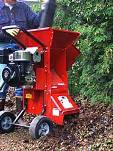Living with Fire – Vegetation Management
Disposing of Debris
When you’re removing and reducing vegetation, the question that is commonly asked is, “What do I do with all of this debris?” If you are doing things right, you can expect some large debris piles – fire hazards in themselves. There are many options for managing this debris, among them are chipping, burning and pile distribution. Read our Tuolumne County Master Gardeners news story about different types of mulch.
Chipping

A preferred option is to chip your material using a chipper/shredder machine which you can either rent or buy. Chipping is recommended because it minimizes fire hazards and air pollution while providing a useful byproduct. Chips can be used as mulch that will provide weed control, protection from soil erosion, and as a soil amendment or composting material. Check this list of local county run Chipping Centers if you prefer to avoid the task of chipping your debris yourself.
Chipping Large Limbs
For large limbs and big piles, it may make sense to rent a commercial size chipper. For significant acreage, most garden variety mulching shredders will be inadequate. They take too long and cannot tolerate hard-to-chip or large material. Neighbors often pool their resources to collectively rent a commercial chipper, though this requires advance planning and organization. The material must be pre-piled and accessible to maximize the efficiency of the chipper’s use.
Burning
While many people are not comfortable with burning debris for a variety of reasons, it remains a viable option. Piles should be kept to a small size and monitored closely until completely out. When you get a burn permit from the fire department, carefully read the safety precautions and follow them to the letter. Click here for burn day information.
If you have a minimal amount of debris compared to the size of your parcel, you may want to simply leave small piles without burning or chipping them. These piles can provide nesting habitat for game birds like quail, but may also be attractive to rodents and reptiles. With this in mind, along with the associated fire hazard, keep them small and distribute them away from structures and existing vegetation.
Planning Ahead
Preventative measures are a good way to avoid the yearly headaches of removing and reducing large amount of vegetation. Routine maintenance like pruning, mowing, and raking is a good start, but other options are available. Controlled grazing is a particularly effective way of managing thick stands of annual grasses and edible weeds. The disadvantage is dealing with the animal, most likely goats or sheep. But an animal, or animals, may also be shared among friends, family or neighbors, reducing the burden of care.
Prescribed Burning
Prescribed, or controlled, burning is an option being promoted by ecologists as well as fire prevention experts. There are numerous benefits associated with this strategy including improved grass stands and the promotion of native species. However, burning must be done under the direction of qualified fire professionals and may be prohibitively expensive for small acreage. The Vegetation Management Program (VMP), administered by the California Department of Forestry and Fire Protection, provides some cost-share incentives to landowners interested in prescribed burning.
Hiring Help
Make sure that anyone working on your property is properly licensed and insured. Be sure to get written agreements regarding clean-up, prices and other conditions. To inquire about the health of your trees and get recommendations for thinning, consult with a Certified Arborist. For removal of dead or downed trees or selective tree removal on property over 20 acres a forester needs to be involved. Area Forester Roger Petersen in Tuolumne County, at 532-7424, ext. 109; or Gary Whitson in Calaveras County, at 754-2708 or contact the local HWY 108 Fire Safe Council or Calaveras Foothills Fire Safe Council. You may need to use CAL fire’s Timber Regulation and Forest Restoration forms. Check our Yellow Pages for Tree Specialists in our area.
Plan Long Term
Whatever strategy best meets your needs, keep in mind that an easily maintained fire-resistant landscape is not created overnight. Think over the long term and plan for a steady transition to your ideal situation. When faced with the seemingly daunting task of fuel reduction, start at your home and work outward. Creating defensible space is the priority.
Events
Tuolumne Veterans Hall | 8:00 am - 4:00 pm
Breakfast With Santa
Sonora Family Moose Lodge | 9:00 am - 11:00 am
Stuff the Bus
Sonora Walmart | 9:00 am - 4:00 pm
Mother Lode Fairgrounds Manzanita Building | 1:00 pm - 7:00 pm
Christmas Flea Market
Tuolumne Veterans Hall | 8:00 am - 4:00 pm
Live Nativity
Sierra Bible Church | 6:30 pm
Crystal Falls | 5:00 pm - 9:30 pm
Christmas Tree Lot
Christmas Tree Lot | 3:00 pm - 7:00 pm
Christmas Light Show
Christmas light show | 6:00 pm - 9:00 pm
Crystal Falls | 5:00 pm - 9:30 pm
Christmas Tree Lot
Christmas Tree Lot | 3:00 pm - 7:00 pm
Christmas Light Show
Christmas light show | 6:00 pm - 9:00 pm
Manzanita Building, Motherlode Fairgrounds | 12:00 pm - 5:00 pm
Christmas Eve Service
Sonora United Methodist Church, Sonora CA | 2:00 pm - 3:00 pm
St. Matthew Lutheran Christmas Eve Service
St. Matthew Lutheran Church | 5:00 pm - 6:00 pm
